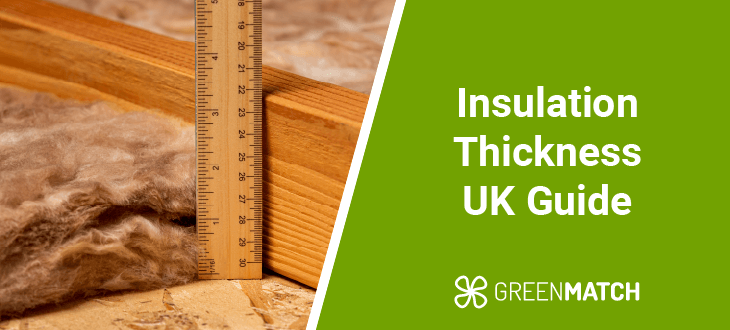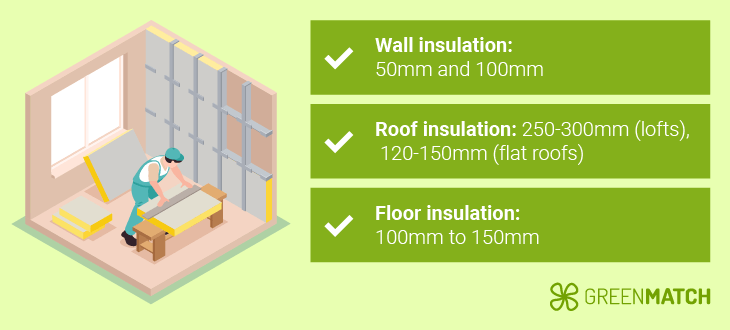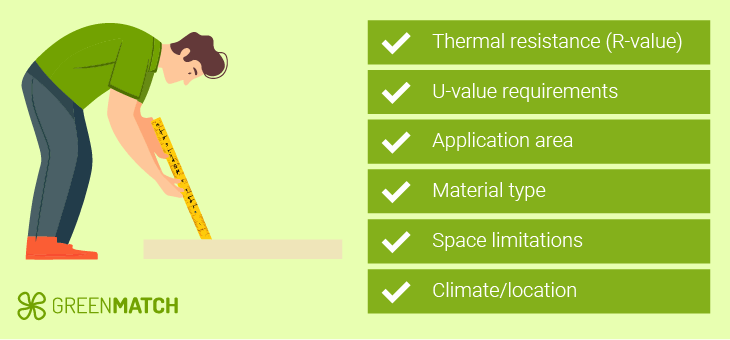Answer these simple questions and we will find you the BEST prices
Which type of solar quotes do you need?
It only takes 30 seconds
100% free with no obligation

Get Free quotes from insulation specialists near you

Save money by comparing quotes and choosing the most competitive offer

The service is 100% free and with no obligation
- GreenMatch
- Insulation
- Thickness
Insulation Thickness: A Complete UK Guide (2025)


- Insulation thickness ranges from 50mm to 300mm, depending on the application area and material used.
- Wall insulation is usually 50 to 100mm thick; floor insulation ranges from 100 to 150mm; flat roof insulation is 120 to 150mm, and pitched roof insulation is 250 to 300mm.
- Proper insulation thickness reduces heat loss, saves costs and reduces carbon emissions.
Proper insulation is one of the simplest ways to save energy, cut costs, and reduce heat loss. But how thick should it be? The answer depends on factors like the application area, material, and UK regulations. For instance, 270mm of loft insulation can save £225 annually, while 100-150mm of rigid foam in walls or floors boosts efficiency and lowers bills. Beyond savings, the right thickness minimises heat loss and slashes your carbon footprint.
This guide covers everything you need to know about insulation thickness—recommended levels for walls, roofs, and floors, the best materials like mineral wool and PIR boards, and key factors like R-values and U-values. You'll also learn how to choose the right insulation for your home and why working with professionals ensures the best results.
Ready to take the next step? We can help you find up to 3 free quotes from trusted insulation installers in your area. Avoid the stress of endless research and comparisons—just fill out our quick form, and we’ll handle the rest. Click below now!
- Describe your needs
- Get free quotes
- Choose the best offer
It only takes 30 seconds



How thick should insulation be?

When it comes to insulation thickness, there’s no one-size-fits-all answer—it depends on the part of your home you’re insulating. However, meeting the UK building regulations for insulation thickness is key to improving energy efficiency, reducing heat loss, and creating a cosy, cost-effective home. Let’s explore the basics:
Wall insulation: The thickness of wall insulation typically ranges between 50mm and 100mm, depending on the material. Internal solutions like rigid foam boards generally require less thickness compared to external systems but are both designed to meet the U-value of 0.30 W/m²K, as required by UK building regulations.
Roof insulation :Since roofs account for significant heat loss, thicker insulation is needed. 250mm to 300mm is the recommended range for lofts using mineral wool rolls. For flat roofs, 120mm to 150mm of rigid foam boards will meet UK regulations.
Floor insulation: Floor insulation thickness depends on the setup, whether above or below a concrete slab. A thickness of 100mm to 150mm of rigid foam is typically required to meet the U-value standard of 0.25 W/m²K.
Recommended insulation thickness for various materials
Insulation thickness varies by material and where it’s applied, such as walls, roofs, or floors. Selecting the right material and ensuring it meets UK building regulations is essential for energy efficiency and comfort.
The table below highlights common materials and their ideal thickness:
| Material | Application | Recommended thickness |
|---|---|---|
| Mineral wool | Walls & roofs | 270mm (loft), 100mm+ (walls) |
| PIR boards | Walls, floors & roofs | 100-150mm |
| Polystyrene (EPS) | Walls & roofs | 100-150mm |
| Sheep’s wool | Walls & roofs | 200-250mm |
| Cellulose | Walls & roofs | 200-250mm |
| Polyurethane foam | Walls & roofs | 120-150mm |
| Rigid foam boards | Floors & flat roofs | 120-150mm |
PIR boards and polyurethane deliver excellent thermal performance with less thickness than materials like mineral wool or natural options. The required insulation thickness also depends on the application area, with roofs needing more due to higher heat loss, while walls and floors can achieve efficiency with thinner layers.
Sustainability is an important factor; eco-friendly materials like sheep’s wool or cellulose are great for reducing environmental impact but typically need greater thickness to match the performance of synthetic alternatives.
What factors affect the thickness of insulation?

The thickness of insulation depends on various factors that influence its performance and suitability for different areas of your home. From material type to specific application needs, understanding these considerations is essential for making the right choice. Here’s what you need to know:
- Thermal resistance (R-Value): The higher the R-value of an insulation material, the better it resists heat flow, meaning less thickness is required to achieve the desired performance. Materials like PIR boards or polyurethane foam offer higher R-values, so thinner layers may suffice compared to materials like mineral wool.
- U-Value requirements: UK building regulations set specific U-value limits for different areas of a home, which directly influence the minimum insulation thickness needed. For walls, the U-value must not exceed 0.30 W/m²K, while floors should meet a limit of 0.25 W/m²K, and roofs must achieve 0.16 W/m²K. These values ensure energy efficiency and compliance with regulations; for example, loft insulation thickness is typically 270mm of mineral wool to meet the U-value standard.
- Application area: The area where insulation is applied—whether walls, roofs, or floors—greatly affects the thickness required. Roofs tend to lose more heat than walls or floors, making thicker insulation essential, particularly in lofts or pitched roofs. This difference highlights the importance of tailoring insulation thickness to each specific application.
- Type of material: The type of insulation material plays a crucial role in determining thickness, as different materials vary in thermal efficiency. Mineral wool is an affordable option but generally requires greater thickness. In contrast, PIR boards offer high thermal performance, allowing for thinner layers to achieve the same efficiency. For those seeking sustainable options, sheep’s wool is eco-friendly but needs more thickness to match the performance of synthetic alternatives.
- Space limitations: In areas like floors or cavity walls, space constraints may limit insulation thickness. High-performance materials like PIR boards are ideal in such cases due to their ability to deliver thermal efficiency in thinner layers.
- Climate and location: Homes in colder regions may require greater insulation thickness to maintain indoor warmth, as heat loss is more significant during winter months.
How to figure out the ideal insulation thickness
Determining the right insulation thickness for your home depends on several factors, including the area being insulated, the type of insulation material, and UK building insulation regulations. Getting it right is essential for improving energy efficiency and maintaining a comfortable indoor environment.
- Identify the area being insulated: The thickness you need depends on whether you're insulating walls, roofs, or floors. For example, lofts typically require 270mm of mineral wool, while floors and walls often need 100-150mm of rigid foam insulation.
- Understand UK building regulations: Each area of your home has specific U-value requirements set by UK regulations. For instance, walls require a maximum U-value of 0.30 W/m²K; floors require a maximum U-value of 0.25 W/m²K and roofs need a U-value of 0.16 W/m²K maximum. These requirements will guide you in selecting insulation thickness.
- Consider the insulation material: The type of insulation material significantly affects thickness. High-performance materials like PIR boards require less thickness to achieve the same results as more traditional options like mineral wool. For example, 100-150mm of PIR may be sufficient, whereas mineral wool needs 200-300mm.
- Factor in your home’s specific needs: When insulating your home, colder areas may need thicker insulation to compensate for heat loss. Additionally, older properties may require more extensive insulation compared to newer, better-sealed homes.
Calculating the right insulation thickness can feel overwhelming, especially when trying to balance performance, budget, and compliance with building regulations. That’s where working with a professional can make all the difference—they’ll assess your home, recommend the ideal materials, and ensure everything meets UK standards, saving you time and stress.
Not sure where to start? We can connect you with up to 3 free quotes from trusted insulation installers in your area. Avoid the hassle of endless research—just fill in our quick form, and we’ll take care of the rest!
- Describe your needs
- Get free quotes
- Choose the best offer
It only takes 30 seconds



FAQ
Insulation should be as thick as required for the specific area and material. For lofts, 270mm of mineral wool is recommended, while walls and floors typically require 100-150mm of rigid foam to meet UK building regulations.
According to UK building regulations, 270mm of mineral wool is the standard recommendation for loft insulation to achieve the required U-value of 0.16 W/m²K for energy efficiency. Therefore, 100mm is not sufficient for compliance or optimal thermal performance.
In most cases, 75mm is not enough to meet UK building regulations. It may work for limited applications with high-performance materials, but thicker insulation is generally needed for compliance.
For walls, 50mm of insulation may only be sufficient when using high-performance materials like PIR boards. However, most walls require at least 100mm of insulation to comply with UK building regulations.
The minimum insulation thickness depends on the material and application, but UK regulations typically require 100mm for walls, 270mm for lofts, and 100-150mm for floors.

Nicole Bea Kerr is a content writer for Greenmatch, leveraging her experience in B2B journalism and editing. She is interested in bringing more awareness to sustainability through informative narratives.
We strive to connect our customers with the right product and supplier. Would you like to be part of GreenMatch?

- Describe your needs
- Get free quotes
- Choose the best offer
It only takes 30 seconds



